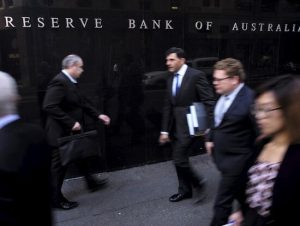Gareth Hutchens* looks at the history of inflation targeting and its bias against workers.
 One of the joys of life is thinking about things in a way you’re not supposed to, and that includes questioning the orthodoxy.
One of the joys of life is thinking about things in a way you’re not supposed to, and that includes questioning the orthodoxy.
It can help you to understand why things are done a certain way or reveal flaws in the current way of doing things.
And it’s also useful to note what ideas and concepts the defenders of an orthodoxy ridicule.
It’s enlightening witnessing how gatekeeping works, and they may be pointing you in the direction of things to read that are far better at explaining how the world works than their own literature.
It’s something to keep in mind this week.
The Reserve Bank board will be meeting again, to discuss lifting interest rates for the seventh month in a row, as some of the world’s major economies head towards recession.
An inflation-targeting regime with a bias
Last week, I wrote an article about a new paper from Greg Jericho from the Centre for Future Work.
The 70-page paper explored the causes of our current inflation, and it laid some blame for our inflation on profiteering by businesses.
It also contained some comments from Mr Jericho about Australia’s “inflation-targeting” regime that has been in place since 1993.
He said the regime has had an anti-worker bias.
And we’ve clearly seen an example of that bias this year, with Australian workers being chastised for asking for wage increases to match or better inflation, while businesses have escaped censure for amassing huge profits, even though their profit-taking has been making this inflation worse.
“Inflation targeting in Australia since 1993 has not been neutral,” Mr Jericho said.
“That period of inflation targeting [especially below-target inflation from 2014 through 2020] was associated with a massive transfer of income and economic power from workers to businesses.
“Monetary policy has not been a technocratic exercise, intended to maximise public welfare in a general sense.
“It clearly reflects, and continues to reflect, value judgements and priorities placed on how the costs and benefits of inflation management are distributed across society.”
I’d like to add some context to those comments because I know they jarred with some people, but I think they’re really interesting.
‘Year zero’ of the new regime
When the Reserve Bank of Australia (RBA) began officially “targeting” inflation in 1993 it was one of the first countries in the world to do so.
Since then, every country has had their own approach to targeting inflation, but the RBA has tried to keep inflation averaging within a range of 2 to 3 per cent over the cycle.
However, that shift to an inflation-targeting regime in the early 1990s didn’t just have economic consequences.
It had social and political ones too.
Why?
Because for the first 80 years of Australia’s federation, roughly speaking, Australia’s labour markets were built on a system of arbitration courts and centralised wage-setting.
That system was an important element of Australia’s famous social contract because it was built to distribute our national income fairly evenly among competing groups in the economy.
It also assumed much of the responsibility for wage restraint and inflation for decades.
But when Australia’s economy was hit by “stagflation” in the 1970s, opponents of that traditional centralised wage-setting and arbitration system made a convincing argument that it was directly responsible for many of Australia’s economic woes.
They said it had been hijacked by special interests, like unions and particular industries, and it was now doing untold economic damage.
So, over the 1980s and 1990s, that old system was dismantled.
And a new system was built in its place, with an “independent” central bank given responsibility in 1993 for controlling inflation by lifting or cutting interest rates.
Centralised wage-setting was abandoned too.
The act of bargaining over wages was handed to individual businesses, where the power dynamics were far more unequal.
Mike Beggs, from the University of Sydney, says 1993 was “year zero” for the new macroeconomic policymaking in Australia, because of those changes.
He’s said it changed Australia’s policy settings in obvious ways.
For example, in 1997 when the Australian Industrial Relations Commission reviewed the level of award wages, the commission decided on wage restraint for the coming year because that’s what the Reserve Bank wanted.
As the commission said in its review: “We have noted the Reserve Bank’s intimations of the order of increase [in wages] which, in its view, accords with its inflation target.
“Any increase greater than the amount which we grant carries a risk, in our view, of leading to a rise in interest rates.”
It was a recognition that the RBA would now be ruling the roost in the new inflation-targeting era, Dr Beggs said.
And the new era coincided with a huge decline in union membership.
A historian weighs in
But fast forward to this year.
In July, the historian Adam Tooze wrote a fascinating article on this topic after reading the annual economic report from the Bank for International Settlements (BIS).
The BIS is based in Switzerland and it’s the central bank for the world’s central banks.
Mr Tooze said the report was enlightening because it showed how the managers of the modern global economic system, “in a remarkably unselfconscious way”, articulate their preference for a particular configuration of social forces.
That is, central banks are very aware of the power dynamics involved in modern inflation targeting, and they know that the inflation-targeting era has coincided with a reduction in workers’ power, and they don’t say it’s a bad thing.
“The BIS is careful to frame its argument symmetrically. It treats pricing power and wage-setting power as dual challenges to inflation control,” Mr Tooze wrote.
“What it does not comment on are the inequality implications.
It does not remark on the fact that the actually existing low-inflation regime of the period since the 1980s opened the door to huge inequality.
“Nor does it address the question of power as such.”
He said it was clear the BIS believes that much of the fight against inflation begins with labour markets.
And he pointed to these passages from the BIS report:
“Labour markets have seen major structural changes since the Great Inflation of the 1970s.
“Their net effect has been to reduce the pricing power of labour.
‘This secular decline reflects many factors, including a declining role of the public sector in setting wages, dwindling unionisation, a wave of labour market deregulation, the gradual opening of markets due to globalisation, and demographics.
“One possible, albeit imperfect, indicator of labour’s decreasing structural pricing power is the secular decline in the degree of centralisation of wage negotiations.”
He said the BIS also provided “this beautiful but ominous set of graphs” to demonstrate how the retreat of collective bargaining in the inflation-targeting era had affected wage growth.
He also said the BIS seemed very aware that periods of persistently high inflation could concentrate people’s minds on their economic situation, and that may, in turn, encourage workers to unionise and ask for more regular wage increases.
He said this appeared to be a risk in the eyes of the BIS, as the BIS report makes clear:
“The higher the inflation rate, the greater the incentive for workers to unionise, and for wage negotiations to be centralised, as the inflation rate acts as a stronger focal point.
“And, the more persistent the inflation rate, the greater the incentive to index wages and, more generally, to reduce the length of contracts that are fixed in nominal terms.
“These forces are amplified by the stylised fact that higher inflation rates tend to go hand in hand with higher volatility and hence uncertainty,” the report said.
But again, Mr Tooze said a lot of the value judgements in the BIS report were not explicitly stated.
They were simply assumed.
“The BIS may be of the view that on welfare and social justice grounds, low-inflation regimes dominate higher-inflation regimes,” he said.
“But it nowhere spells out that argument.
“If that assumption does not hold, then favouring a low-inflation regime implies a distributional and a political choice.”
Could things be improved?
But I’ll have to leave it there.
Mr Tooze’s article is really worth reading because it forces you to think afresh about the world, particularly about questions of power, the choice of instruments to control inflation, and the social consequences that flow from that choice.
Same with Mr Jericho’s paper.
Who is the current system really serving?
Is this the best system we have?
Could there be other ways to tackle inflation?
Could there be fairer ways?
I’m sure there’ll be some economists, ex-central banker types, who’ll be quick to ridicule questions like these.
I’m also sure the world looks very nice from their windows, because they’ve personally done very well from the modern labour market.
But has their gain been experienced by everyone?
It’s interesting to think about.
*Gareth Hutchens is a business and economics reporter based in Canberra.
This article first appeared at abc.net.au.






